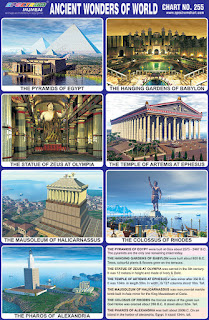 |
Ancient Wonders of World Chart
|
Spectrum Chart - 255 : Ancient Wonders of World
1. The Pyramids of Egypt - Great Pyramid
of Giza is the oldest and largest of the three pyramids in the Giza
pyramid complex bordering what is now El Giza, Egypt. It is the
oldest of the Seven Wonders of the Ancient World and the only one to
remain largely intact. It is believed the pyramid was built as a tomb
for Fourth Dynasty Egyptian pharaoh Khufu and was constructed over a
20-year period. The pyramid remained the tallest man made structure
in the world for over 3800 years, unsurpassed until the
160-metre-tall spire of Lincoln Cathedral was completed c. 1300. The
accuracy of the pyramid's workmanship is such that the four sides of
the base have an average error of only 58 mm in length.
2. The Hanging Gardens of Babylon – The
Hanging Gardens of Babylon, one of the Seven Wonders of the Ancient
World, is the only one whose location has not been definitively
established. Hanging Gardens were described as a remarkable feat of
engineering an ascending series of tiered gardens containing all
manner of trees, shrubs and vines. The gardens were said to have
looked like a large green mountain constructed of mud bricks. Because
no physical evidence for the Hanging Gardens has be found at Babylon
it has been suggested that they were purely mythical, and the
descriptions found in ancient Greek and Roman writers. If it did
indeed exist, it was destroyed sometime after the first century AD.
3. The Statue of Zeus at Olympia – The
Statue of Zeus at Olympia was a giant seated figure, about 13 m tall,
made by the Greek sculptor Phidias around 435 BC at the sanctuary of
Olympia, Greece and erected in the Temple of Zeus there. A sculpture
of ivory plates and gold panels over a wooden framework, it
represented the god Zeus sitting on an elaborate cedar wood throne
ornamented with ebony, ivory, gold and precious stones. One of the
Seven Wonders of the Ancient World, it was lost and destroyed during
the 5th century AD with no copy ever being found and details of its
form are known only from ancient Greek descriptions and
representations on coins.
4. The Temple of Artemis at Ephesus –
The Temple of Artemis or Artemision, also known less precisely as the
Temple of Diana, was a Greek temple dedicated to the goddess Artemis.
It was located in Ephesus. One of the Seven Wonders of the Ancient
World, it was completely rebuilt three times before its eventual
destruction in 401 AD. Only foundations and sculptural fragments of
the latest of the temples at the site remain.
5. The Mausoleum of Halicarnassus -
Mausoleum at Halicarnassus or Tomb of Mausolus was a tomb built
between 353 and 350 BC at Halicarnassus forMausolus, a satrap in the
Persian Empire and his sister-wife Artemisia II of Caria. The
structure was designed by the Greek architects Satyros and Pythius of
Priene. The Mausoleum was approximately 45 m in height, and the four
sides were adorned with sculptural reliefs, each created by one of
four Greek sculptors Leochares, Bryaxis, Scopas of Paros and
Timotheus. The finished structure of the mausoleum was considered to
be such an aesthetic triumph that Antipater of Sidon identified it as
one of his Seven Wonders of the Ancient World. It was destroyed by
successive earthquakes from the 12th to the 15th century.
6. The Colossus of Rhodes - Colossus of
Rhodes was a statue of the Greek titan-god of the sun Helios, erected
in the city of Rhodes, on the Greek island of the same name, by
Chares of Lindos in 280 BC. One of the Seven Wonders of the Ancient
World, it was constructed to celebrate Rhodes victory over the ruler
of Cyprus. The Colossus stood approximately 33 metres high making it
the tallest statue of the ancient world. It was destroyed during the
earthquake of 226 BC and never rebuilt.
7. The Pharus of Alexanderia - Pharos of
Alexandria was a lighthouse built by the Ptolemaic Kingdom between
280 and 247 BC which was between 393 and 450 ft tall. One of the
Seven Wonders of the Ancient World, it was one of the tallest
man-made structures in the world for many centuries. Badly damaged by
three earthquakes between AD 956 and 1323, it then became an
abandoned ruin. The Ministry of State of Antiquities in Egypt has
planned, as of late 2015, to turn submerged ruins of ancient
Alexandria, including those of the Pharos, into an underwater museum.

No comments:
Post a Comment